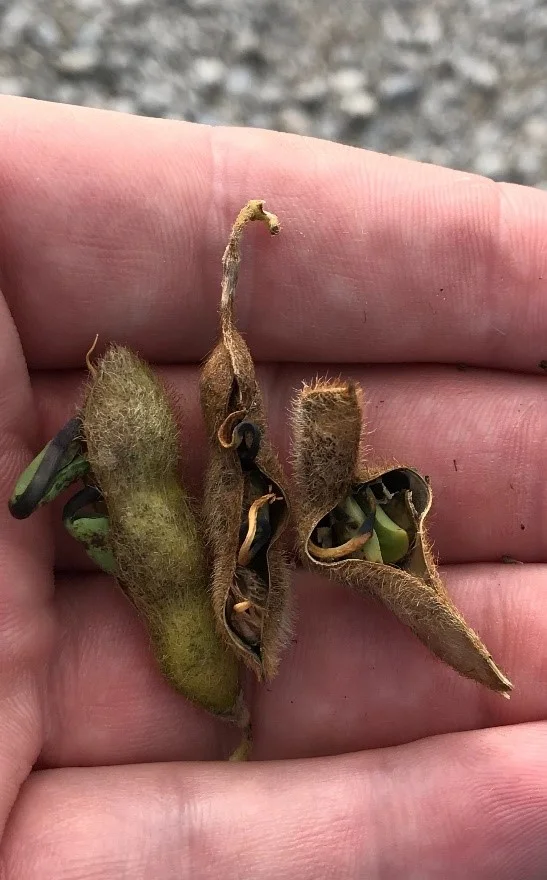Soybean Seed Quality Moving Backwards in the Field
Carl Bradley and Chad Lee
Extension Plant Pathologist and Extension Agronomist, University of Kentucky
The excessive rains of September and early October are more than many soybean plants can handle. The wet weather occurred as soybean seeds were at physiological maturity or approaching it. The entire plants were beginning to shut down as their mission of making seed was complete. The wet weather provided the perfect conditions for various fungi to take advantage of these plants. Also, these conditions favored sprouting while seeds are still in the pods.
This wet weather also provided a perfect environment for saprophytic fungi to colonize soybean plants, and for plant pathogenic fungi to colonize stems and pods and infect seeds. Most notable are the pathogens that cause Phomopsis seed decay and purple seed stain. Phomopsis seed decay is especially known for reducing seed germination, and both Phomopsis seed decay and purple seed stain may reduce other quality measures, such as oil and protein concentrations.
The primary way to manage Phomopsis seed decay and purple seed stain is to harvest soybean fields as soon as possible after they are mature. When significant rainfall occurs after soybeans become mature, the risk of these seed diseases greatly increases. The fungi that cause these diseases over winter on soybean residue in fields and can be seedborne. Therefore, crop rotation and avoiding planting bin-run seed also may help reduce risk of these diseases. Foliar-applied fungicides may have some effect on these diseases, and protection against these diseases may slightly increase if they are applied at the R5 growth stage (beginning seed stage). However, when high amounts of frequent rainfall occur after fields are mature, the effectiveness of these management practices may be limited.
Seed sprouting in the pod is a rare occurrence. Firstly, soybean seeds must dry below about 55% moisture at which seeds reach physiological maturity. Secondly, seeds that were below about 55% moisture must imbibe enough water to go back above 55% moisture in order for seeds to sprout. This order of events is extremely rare on upright soybean plants where pods are exposed to air and sunlight as leaves drop.
The drying and wetting of soybean pods weakens the pods. As the pods dry down a second or third time, many pods will split and drop seeds on the soil surface.
Farmers can expect lower yields and damaged seed. Damaged seed is likely to receive discounted prices from grain buyers. Farmers who have drying capacity could try to harvest soybean fields as soon as field conditions and machinery performance allow.
The wet weather this summer was a blessing to crop growth and higher yields. The wet weather at soybean maturity was a curse to seed quality and yields.
Figure 1 Discolored soybean pods due to a mixture of saprophytic fungi, plant pathogenic fungi, and nymphs of Green Stink Bug (Chinavia hilarus). Photo by Austin Sherman, graduate student.
Figure 2. Soybean seeds affected by diseases such as Phomopsis seed decay and purple seed stain. Photo by Joanna Coles, UK Cooperative Extension, Warren Co., KY
Figure 3 Soybean seeds sprouting in the pod. Photo by Brett Reese, Southern States Cooperative.



